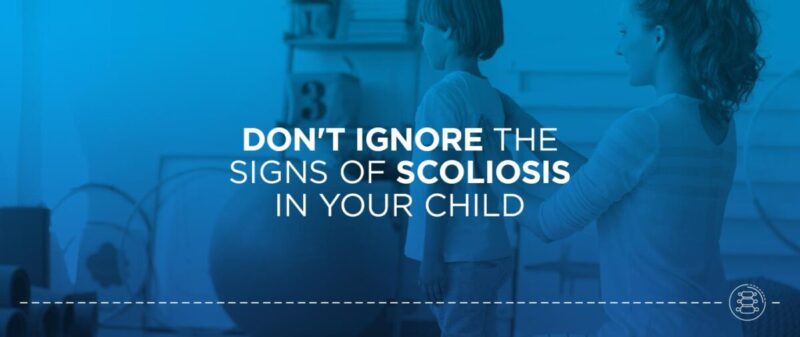

Scoliosis is a common back condition found in children, teenagers, adults and older adults alike. Although most people have a pretty good understanding of this condition, do you think you could recognize the signs of scoliosis in your child? Children are at a crucial developmental stage in their lives where growth spurts can hide the physical symptoms of this life-altering condition.
During these early stages of life, it’s crucial to examine your child’s back and posture as their height changes. Doctors can also monitor pediatric scoliosis during your child’s regular checkups, and specialists can recommend observation and treatment options. For parents, knowing the different forms of scoliosis in children and their symptoms can help identify early signs of this condition before discomfort arises.
Adolescent scoliosis is a condition in which the curvature of the spine can impact posture and cause discomfort or pain during a child’s physical development. The spine will bend to the side in a “C” or “S” shape rather than forming a straight line. Although a scoliosis diagnosis typically occurs in a patient’s teen years, this condition still impacts many children when it begins to form.
Scoliosis is treated based on the curvature degree of the spine. If the spine curves 10-24 degrees, there is usually a smaller risk for progression. A curve of 25-40 degrees is more moderate, and a doctor should begin monitoring this condition. Any bend that exceeds 45 degrees is a severe case of scoliosis that needs immediate treatment. Pediatricians and spine specialists typically measure the shape of the spine.
Early-onset scoliosis (EOS) is one of the most common diagnoses in children 10 years and younger. Doctors monitor this condition closely as a child’s height continues to increase at a fast pace, which can sometimes impact the spine. Since their growth significantly changes during these years of development, children will usually need a scoliosis exam during routine checkups and physicals.
Although there is no direct cause of pediatric scoliosis in children, parents must keep track of any family history involving back pain or discomfort. Scoliosis tends to trickle down from generation to generation.
Scoliosis in children with no direct cause is called adolescent idiopathic scoliosis (AIS). This type of scoliosis typically develops during children’s growth spurts, making it difficult to recognize unless regularly examining a child’s back or posture.
Some forms of scoliosis have a more specific cause. These conditions are:
Whether an adolescent scoliosis condition has a direct cause or has been developing since birth, recognizing the symptoms of scoliosis in children is crucial for their long-term health as they continue to grow.
Signs of scoliosis can vary between children and their conditions. A few possible scoliosis symptoms can include:
Cases of congenital scoliosis can also result in kidney and bladder problems in newborns and toddlers. In some rare cases, symptoms of congenital scoliosis also include numbness or weakness in various areas around the body due to issues in the nervous system.
NMS can show physical conditions similar to cerebral palsy, where the condition is more visible upon first inspection. This form of scoliosis can cause the back to hunch forward. In severe cases, children can experience breathing problems due to the lungs’ inability to fill with air properly.
Pediatric scoliosis is a complicated condition that can be challenging to recognize if not regularly monitored. Most cases of scoliosis go untreated for years until a child becomes a teenager and begins to notice discomfort in movement or posture. Moderate scoliosis does not usually need treatment. Keeping an eye on the curvature degree each year can help ensure the condition does not worsen.
In severe cases, however, the spine may curve about one degree more each year. Because of the curvature of the spine, the body can start shifting internally in uncomfortable ways. This can force organs and bones to shift around, which can cause heart and lung damage. In these circumstances, surgery or physical therapy can help correct the spine’s shape, which a back brace can continue to keep straight.
Long-term health complications can occur in scoliosis patients with severe cases without the proper treatment options.
If your child shows any back discomfort or pain, we suggest contacting their pediatric doctor or a specialist to conduct a physical examination. During the exam, the doctor can see if the spine is visibly curved. Depending on the curvature degree of the spine that the doctor notes, an X-ray, CAT scan or other screening procedures may take place to obtain an image of the back and determine the severity of the child’s scoliosis.
From here, treatment options vary by patient and the status of their condition. Moderate cases must continue observation to monitor the curvature degree each year. Severe cases typically require physical therapy appointments to help movement and posture become more comfortable. This treatment allows a child to begin alleviating pain in their back through carefully orchestrated exercises to increase mobility gradually. Although rare for children, some patients might undergo surgery to straighten the spine for more immediate relief.
If you think your child may have a form of scoliosis, the New York Spine Institute is here to help. Our dedicated team of neurosurgeons and physicians care deeply for your child’s condition and can offer quality care at every step of the treatment process.
Learn more about our team of experts in the scoliosis division from Long Island. Or, schedule a consultation today to work out the next steps for you and your child.